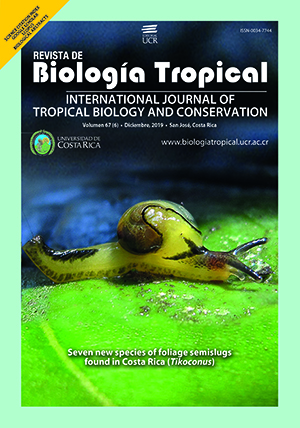Resumen
La variación genética entre las poblaciones insulares y continentales de la hormiga cortadora de hojas Atta cephalotes ha sido poco estudiada, a pesar de su importancia para comprender su capacidad de dispersión, la estructura regional y la distribución de una de las especies más abundantes en el neotrópico. Objetivo: Analizar la variación genética de una población insular de esta hormiga cortadora de hojas en un contexto regional más amplio para América Central y del Sur. Métodos: Se secuenció el gen de la Citocromo oxidasa I de Atta cephalotes para las poblaciones de la isla Gorgona y el continente para realizar un análisis de la varianza molecular, la selección de modelos del flujo de genes, así como para calcular el tiempo de divergencia de los haplogrupos que circulan en la isla. Se realizó una prueba de asignación de individuos para estimar la conectividad genética espacial y la distribución de esta hormiga en el Pacífico Oriental Tropical. Resultados: un total de 33 muestras de la isla y el continente colombiano se compararon con 389 accesiones de Genebank de Atta cephalotes de América Central y del Sur. La hormiga cortadora de hojas en la isla Gorgona está estrechamente relacionada con el continente colombiano a pesar de que la separación entre la isla y el continente probablemente constituya una barrera para el flujo de genes. Los haplogrupos más comunes en el continente probablemente llegaron a la isla en algún momento hacia final del Pleistoceno. Sin embargo, no se puede excluir la influencia antropogénica en la reciente colonización de la isla por esta hormiga cortadora de hojas. Un mapa de conectividad muestra que esta población tiene límites geográficos que se superponen en gran medida con una región biogeográfica dentro del Pacífico Oriental Tropical. Esta población trans-andina acumula el 23% de la diversidad de herencia matrilineal de Atta cephalotes. Conclusiones: la hormiga cortadora de hojas en la isla Gorgona y el Pacífico colombiano está estrechamente relacionada con la población centroamericana y toda esta región alberga un segmento significativo de la diversidad genética de Atta cephalotes en América del Sur.
##plugins.facebook.comentarios##

Esta obra está bajo una licencia internacional Creative Commons Atribución 4.0.
Derechos de autor 2019 Alejandra López, Raúl Ernesto Sedano Cruz







